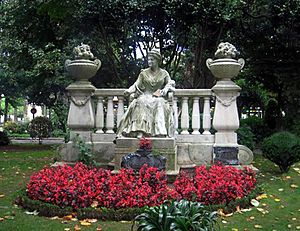Emilia Pardo Bazan facts for kids
Emilia Pardo Bazán (born 16 September 1851 – died 12 May 1921) was a famous Spanish writer and scholar. She was also known as Emilia, countess de Pardo Bazán.
Emilia was born in A Coruña, a city in the region of Galicia. The culture of Galicia was very important to her. She often included it in her most popular novels. Two of these are Los pazos de Ulloa (which means The Manors of Ulloa) and its follow-up, La Madre Naturaleza (Mother Nature). She was also known for bringing a style called naturalism to Spanish writing. This style focuses on showing reality in great detail. Emilia Pardo Bazán was also a key figure in the feminist writing of her time.
Contents
Who Was Emilia Pardo Bazán?
Emilia Pardo Bazán was a very important person in Spanish literature. She was a writer, a journalist, and a scholar. She helped change how stories were told in Spain. She also fought for women's rights through her writing.
Early Life and Interests
Emilia married Sr D. Jos Quiroga when she was eighteen. He was a gentleman from the countryside of Galicia. Emilia became very interested in politics. She is believed to have worked secretly against the king, Amadeo of Spain. Later, she also worked against the republic that followed.
In 1876, Emilia became well-known. She won a writing prize from the city of Oviedo. Her winning essay was about a Benedictine monk named Benito Jerónimo Feijoo. After this, she wrote many articles for a magazine called La Ciencia cristiana.
Her Writing Style
Emilia Pardo Bazán was famous for using "naturalism" in her books. This means she wrote about life as it really was. She included many details about people and places. Her stories often showed how people were affected by their surroundings. She also wrote about social issues.
Fighting for Women's Rights
Emilia Pardo Bazán was a strong supporter of women's rights. She used her writing to talk about the challenges women faced. She believed women should have more opportunities. Her work helped to inspire other women writers. She is seen as an important voice in feminist literature.
See also
 In Spanish: Emilia Pardo Bazán para niños
In Spanish: Emilia Pardo Bazán para niños


